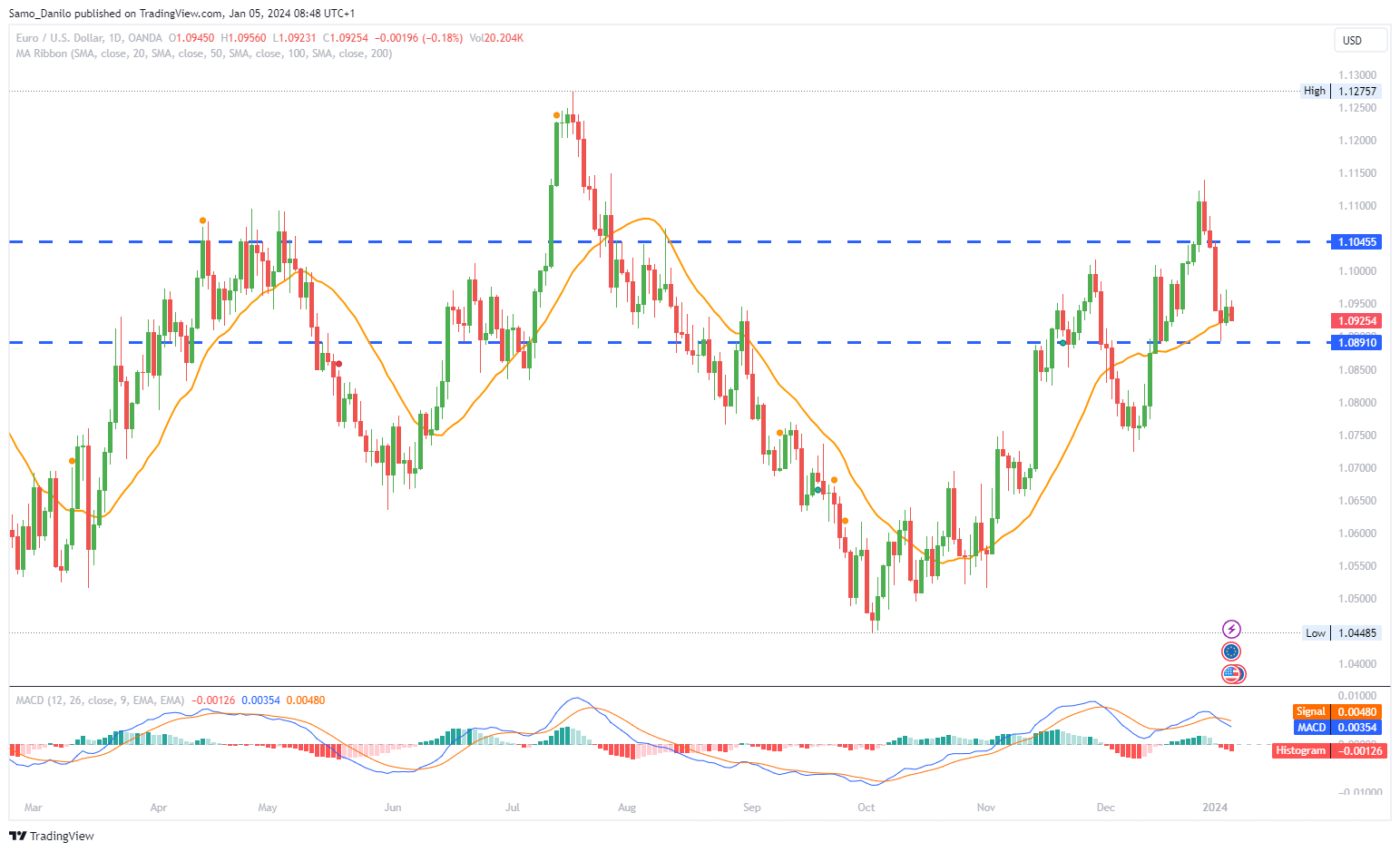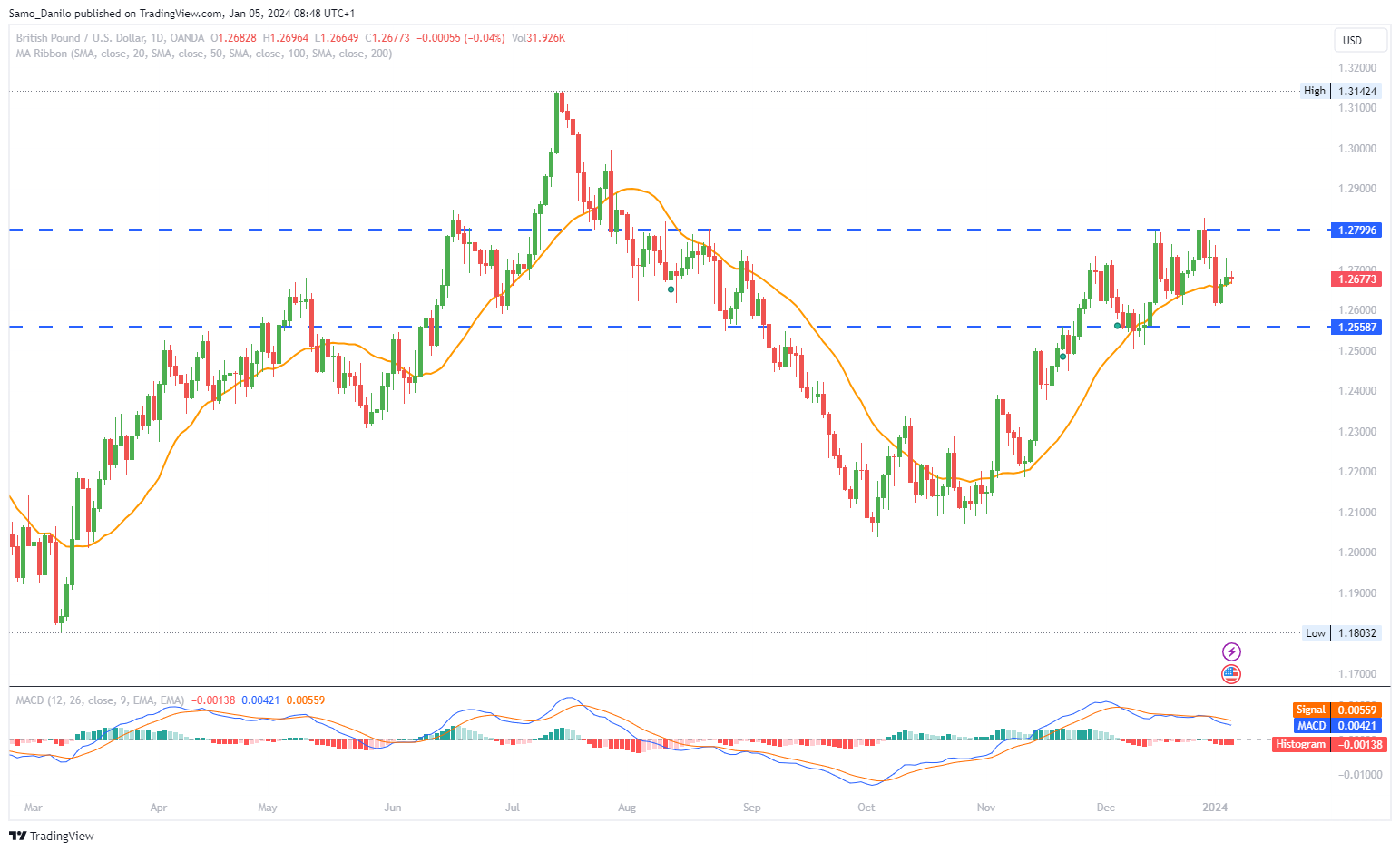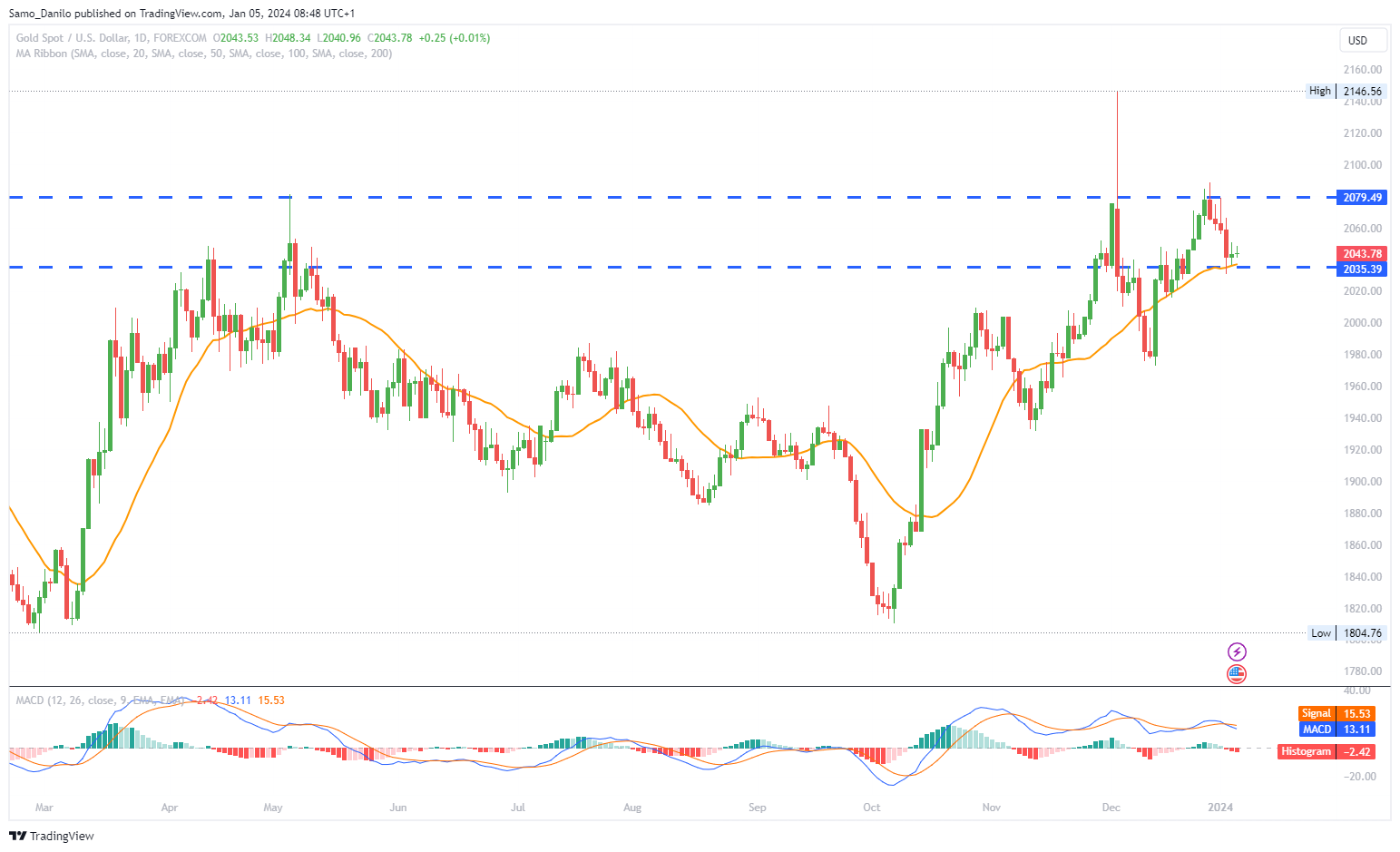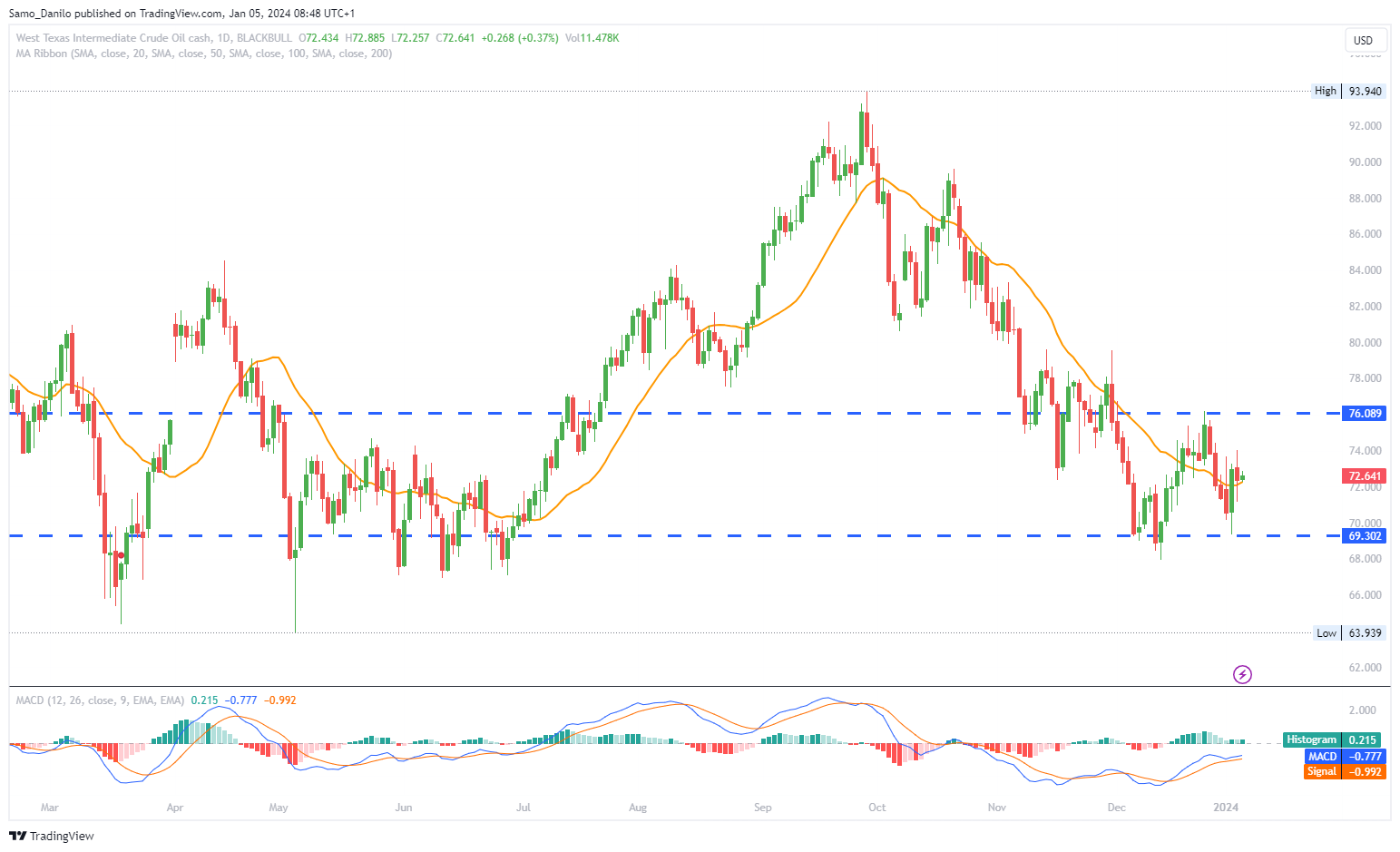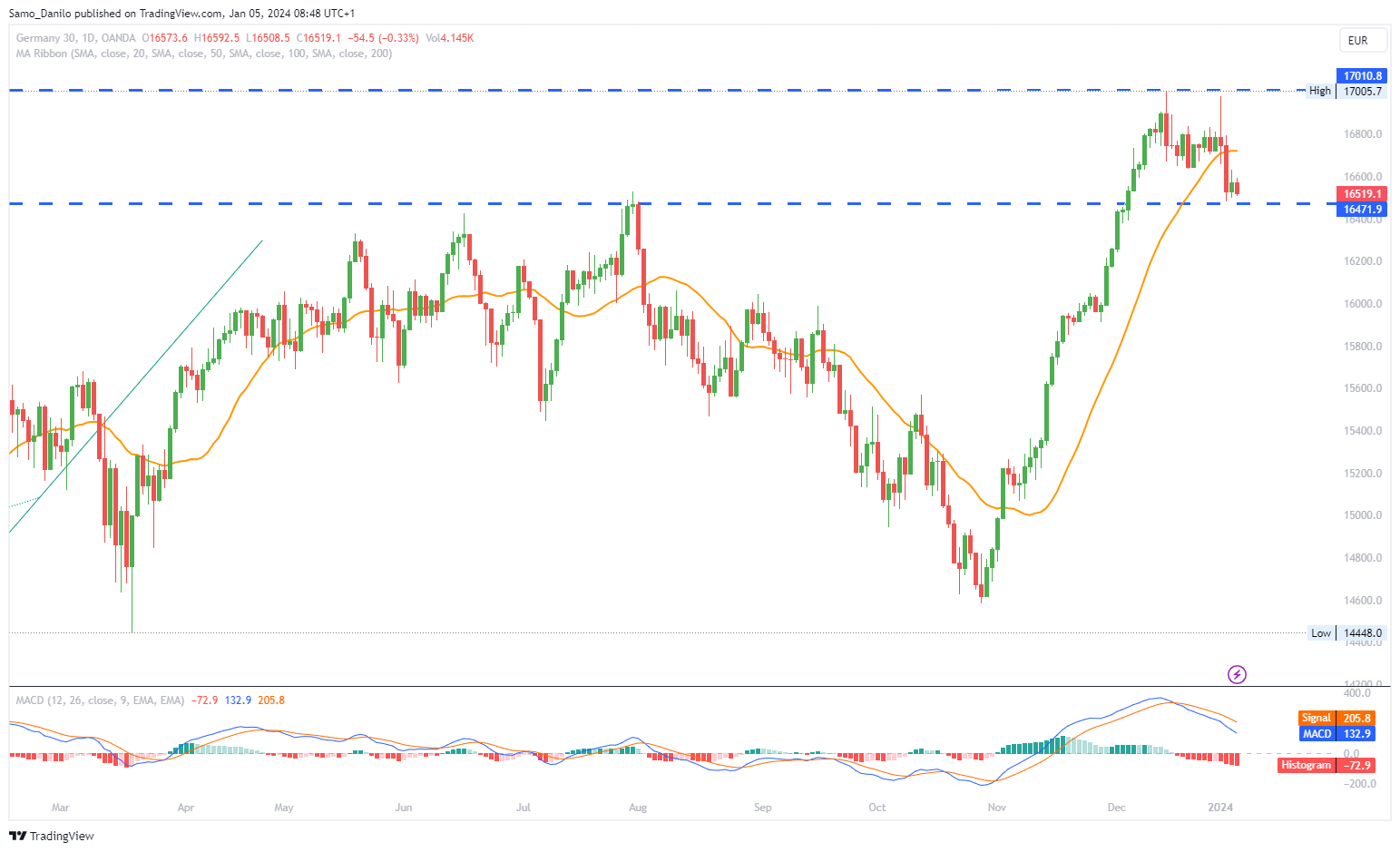EURUSD
- The EUR/USD pair is trading with a positive bias for the second consecutive day. However, this upward momentum lacks follow-through, and the pair remains confined within the broader trading range from the previous day.
- The European currency found support from higher-than-expected preliminary inflation figures in Germany for December. The year-on-year inflation rate in Germany is reported at +3.7%.
- On the other side of the Atlantic, a strong ADP (Automatic Data Processing) employment report for December has contributed to the positive sentiment. The robust ADP figures are seen as reinforcing expectations for another strong reading in the upcoming Nonfarm Payrolls (NFP) report, scheduled for release on the same day.
- The march north in US yields is attributed to a hawkish tilt in the Federal Open Market Committee (FOMC) Minutes released late on Wednesday. The minutes indicated that while the policy rate is expected to peak during the tightening cycle, the exact course of policy will depend on the evolving economic conditions.
- Traders are exercising caution and might prefer to stay on the sidelines ahead of key economic releases, particularly the Eurozone Consumer Price Index (CPI) and the US Nonfarm Payrolls (NFP) report. These events could have a significant impact on market dynamics.
Closing statement: The EUR/USD pair is experiencing a positive bias, supported by strong inflation figures in Germany and optimistic sentiments from the ADP employment report. The upcoming Eurozone CPI and US NFP report are anticipated events that could influence trading decisions as traders exercise caution in their positioning.
GBPUSD
- GBP/USD extends its winning streak for the third successive day, trading higher around 1.2680 during the early European hours.
- The recent strength of the US Dollar (USD) was influenced by the hawkish tone found in the minutes of the Federal Reserve's (Fed) December policy meeting. This, combined with a sharp decline in Wall Street's main indexes, contributed to the USD's resurgence mid-week.
- UK Consumer Credit data showed a rise in individuals' borrowing to £2.005 billion in November, up from the previous £1.411 billion (revised from £1.289 billion). S&P Global/CIPS Composite PMI for December improved to 52.1 from the previous 51.7, while Services PMI increased to 53.4 from 52.7.
- Corporate executives in the UK have urged the Bank of England (BoE) to swiftly lower interest rates to provide support to the struggling economy.
- Traders are eagerly awaiting further data from the US employment market, including key indicators such as Average Hourly Earnings and Nonfarm Payrolls (NFP) for December. Additionally, the ISM Services PMI is expected to provide insights into the current conditions within the US service sector.
| SMA (20) | Slightly Rising |
|
| RSI (14) | Neutral | |
| MACD (12, 26, 9) | Slightly Falling |
|
Closing statement: GBP/USD continues its upward trajectory, fuelled by the recent USD strength and positive economic indicators in the UK. The anticipation is high among traders as they await crucial data from the US, which could significantly impact market dynamics, especially in the context of employment and the service sector.
GOLD
- Gold price continues its struggle to gain meaningful traction on Friday, remaining confined in a narrow trading band below the $2,050 level heading into the European session.
- Geopolitical risks, coupled with China's economic challenges, persist and weigh on investors' sentiment. These factors offer some support to the safe haven gold price on Friday.
- The US published the ADP survey on private job creation, revealing that 164,000 new positions were added. This exceeded market expectations, which were anticipating 115,000 new jobs.
- From a technical point of view, any subsequent move up in gold price might continue to face strong resistance near the $2,050-$2,048 region.
- Today, the US is set to publish the monthly Nonfarm Payrolls (NFP) report. Market expectations are for the report to show the addition of 170,000 new jobs in September.
| SMA (20) | Rising |
|
|
| RSI (14) | Neutral | ||
| MACD (12, 26, 9) | Slightly Falling |
|
Closing statement: Gold remains in a narrow trading band as it grapples with geopolitical uncertainties and economic challenges, particularly in China. The positive ADP job creation data sets the stage for the upcoming US Nonfarm Payrolls report, which could significantly impact gold price dynamics, especially if it deviates from market expectations.
CRUDE OIL
- West Texas Intermediate (WTI) price shows an upward trend, hovering around $72.50 per barrel during the Asian session on Friday.
- The Energy Information Administration (EIA) reported that the US Crude Oil Stocks Change for the week ending on December 29 declined to 5.503 million barrels. This decline exceeded the forecasted 3.725 million barrel decrease.
- The Biden administration is taking a gradual approach to replenishing the Strategic Petroleum Reserve (SPR) following the unprecedented sale of a substantial amount from the emergency stockpile in 2022.
- Crude oil prices experienced an upward surge fueled by escalating tensions in the Israel-Gaza conflict. Additionally, disruptions at a Libyan oilfield contributed to the volatility in oil markets.
- Protests on Wednesday led to a complete shutdown of production at Libya's major Sharara oilfield, capable of producing up to 300,000 barrels per day (bpd).
| SMA (20) | Falling |
|
|
| RSI (14) | Slightly Rising |
| |
| MACD (12, 26, 9) | Slightly Rising |
|
Closing statement: WTI crude oil prices continue their upward trajectory, influenced by a combination of factors, including favourable inventory data, geopolitical tensions, and disruptions at a key Libyan oilfield. The market remains sensitive to geopolitical developments, and traders will likely closely monitor any further escalations or resolutions in conflict zones that could impact oil supply dynamics.
DAX
- Yesterday, the euro area services sector and inflation took center stage. Despite better-than-expected German Services PMI numbers, concerns about a euro area recession persisted.
- A pickup in German inflationary pressures added to uncertainty regarding ECB monetary policy. The annual inflation rate accelerated from 3.2% to 3.7%, reflecting potential challenges for central bank decision-making.
- Better-than-expected service PMI numbers from China contributed to a positive start to the Thursday session, potentially influencing global market sentiment.
- German retail sales figures for November will be of interest to investors on Friday. A larger-than-expected fall in retail sales could support bets on a Euro area recession and impact retail-oriented stocks.
- Eurozone inflation figures for December are also anticipated on Friday, and economists forecast the annual inflation rate to accelerate from 2.4% to 3.0%. This could have a notable impact on market risk appetite.
| SMA (20) | Rising |
|
|
| RSI (14) | Slightly Falling |
| |
| MACD (12, 26, 9) | Slightly Falling |
|
Closing statement: The DAX continues to navigate through a complex economic landscape, with attention to both domestic and global factors. While positive data from China provided an optimistic start, concerns about the Eurozone's economic health persist. Investors will closely monitor German retail sales and Eurozone inflation figures for potential market-moving insights into the region's economic trajectory.
